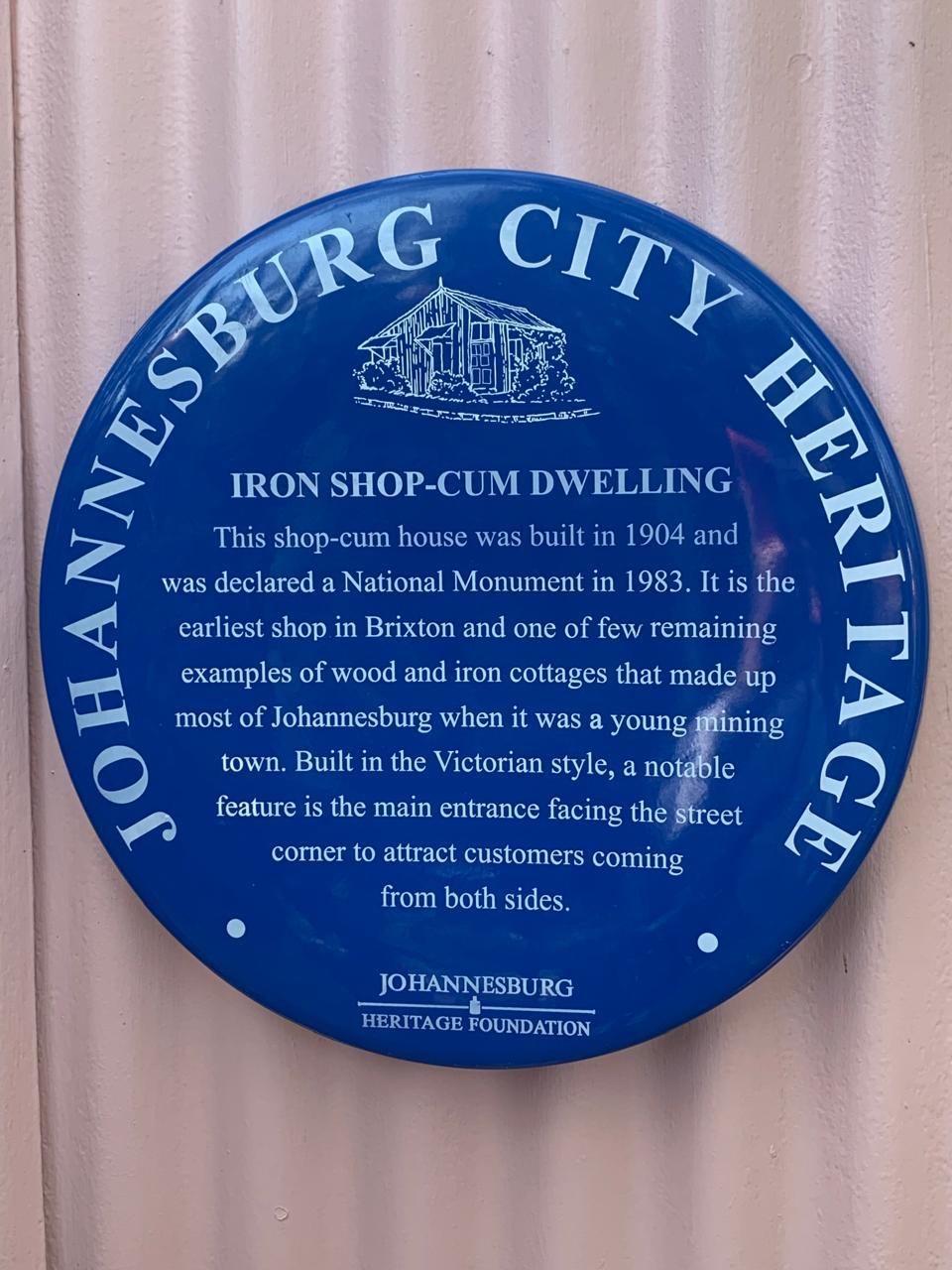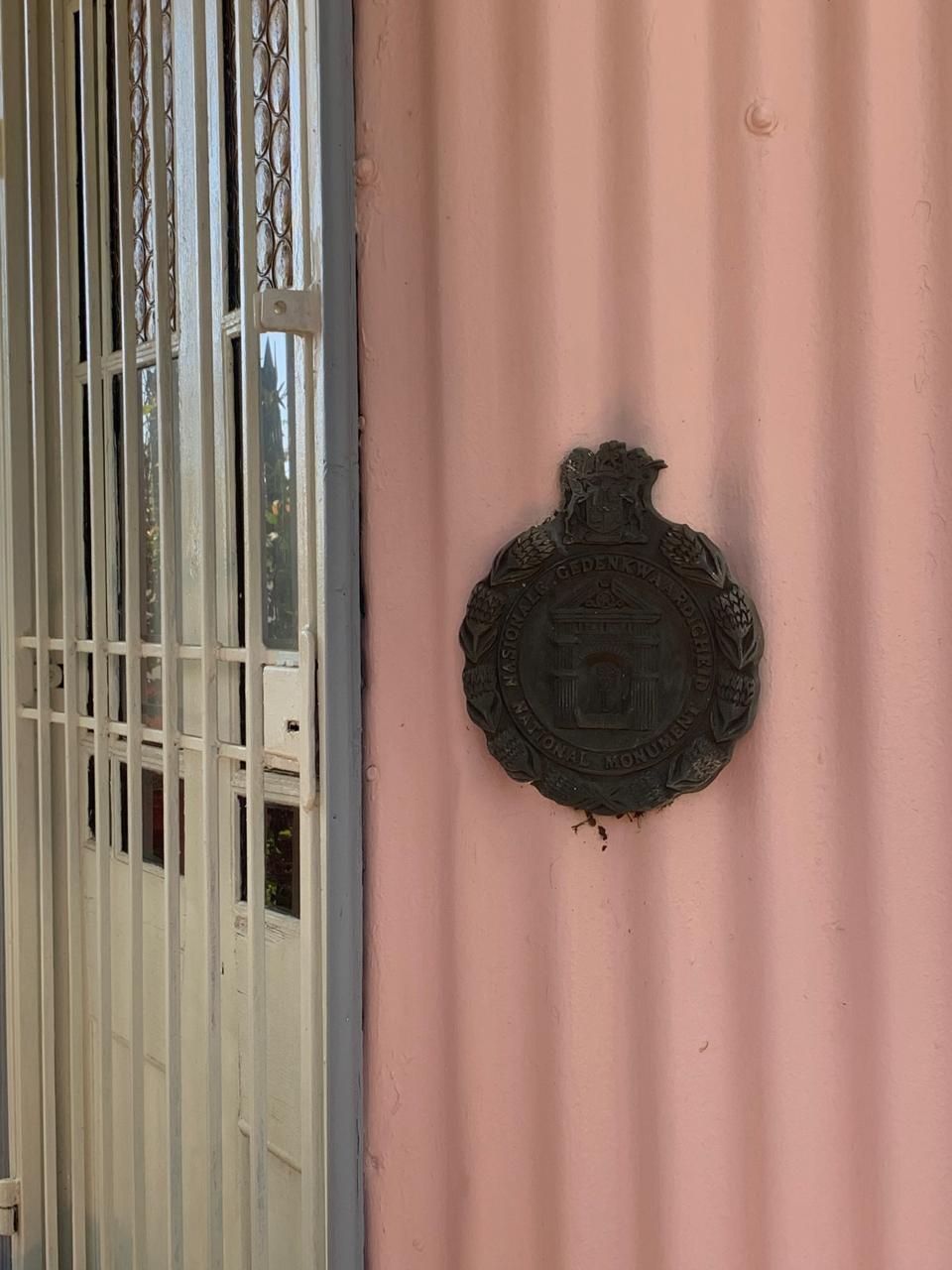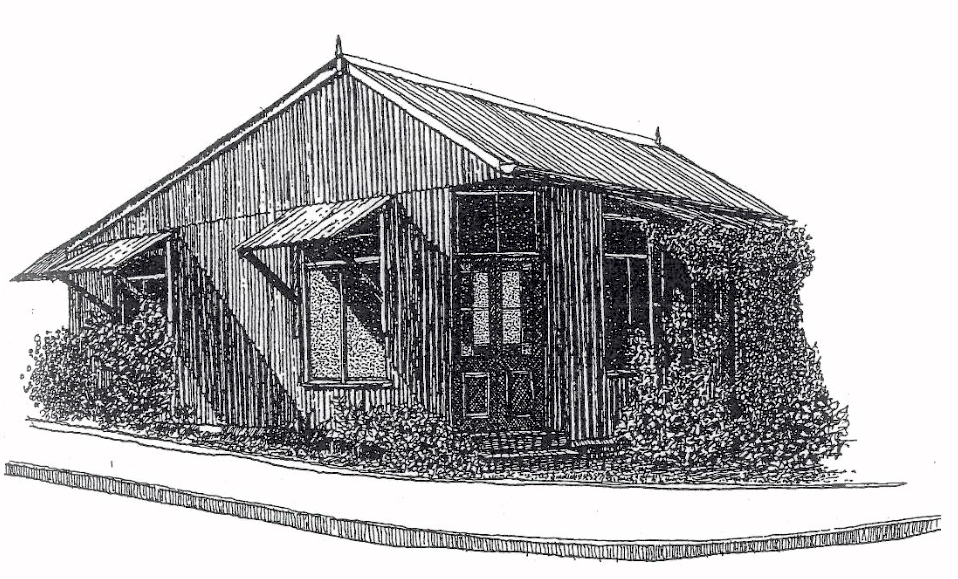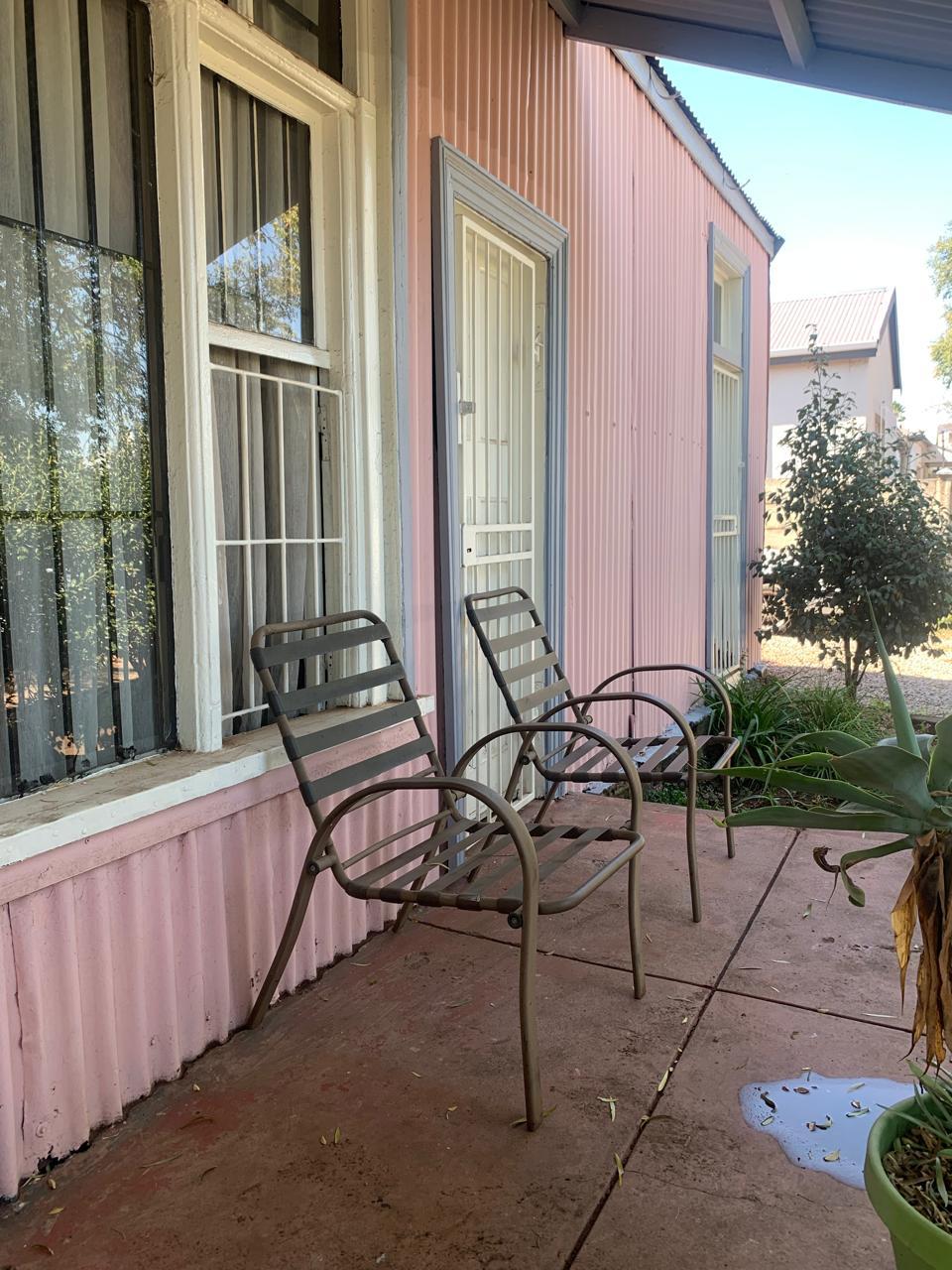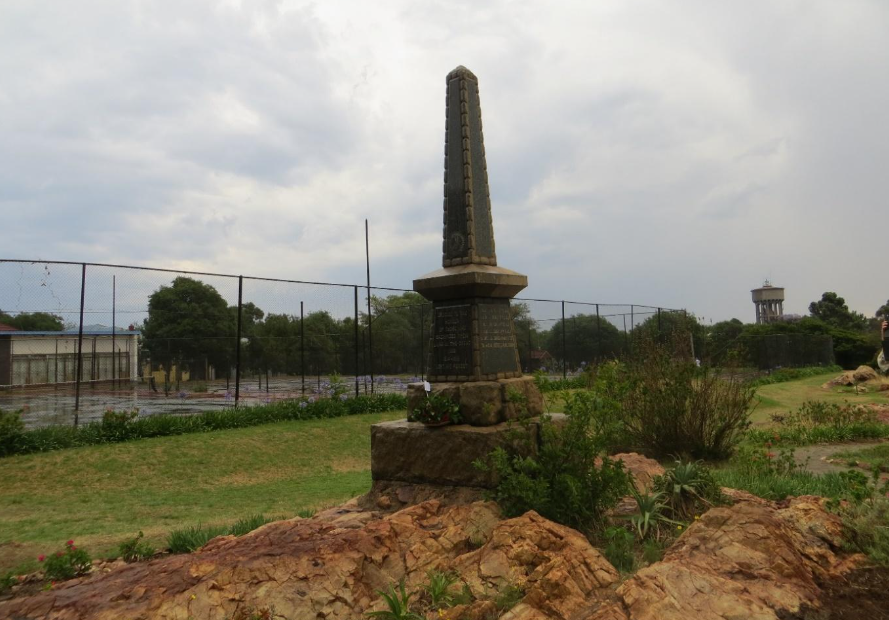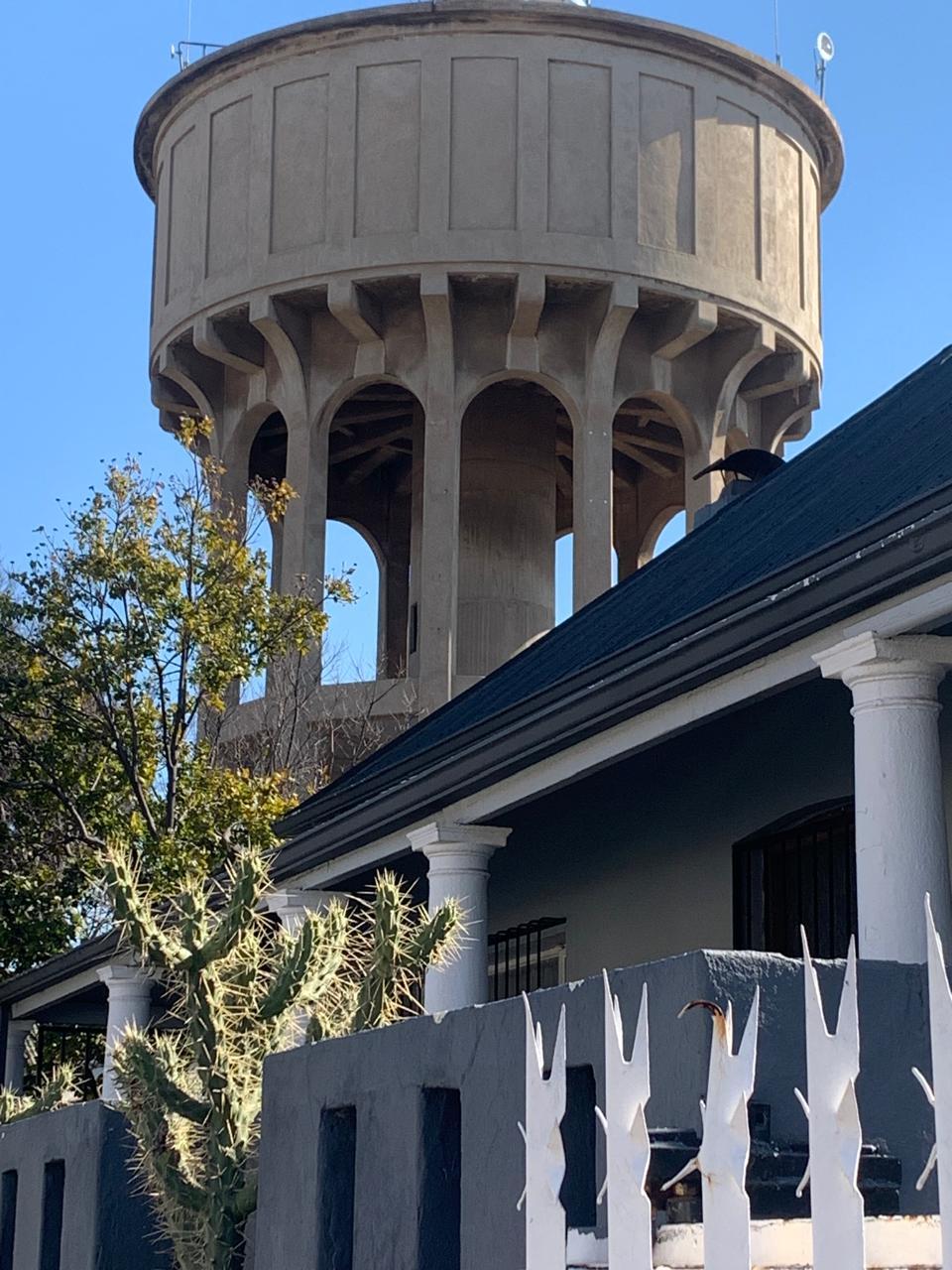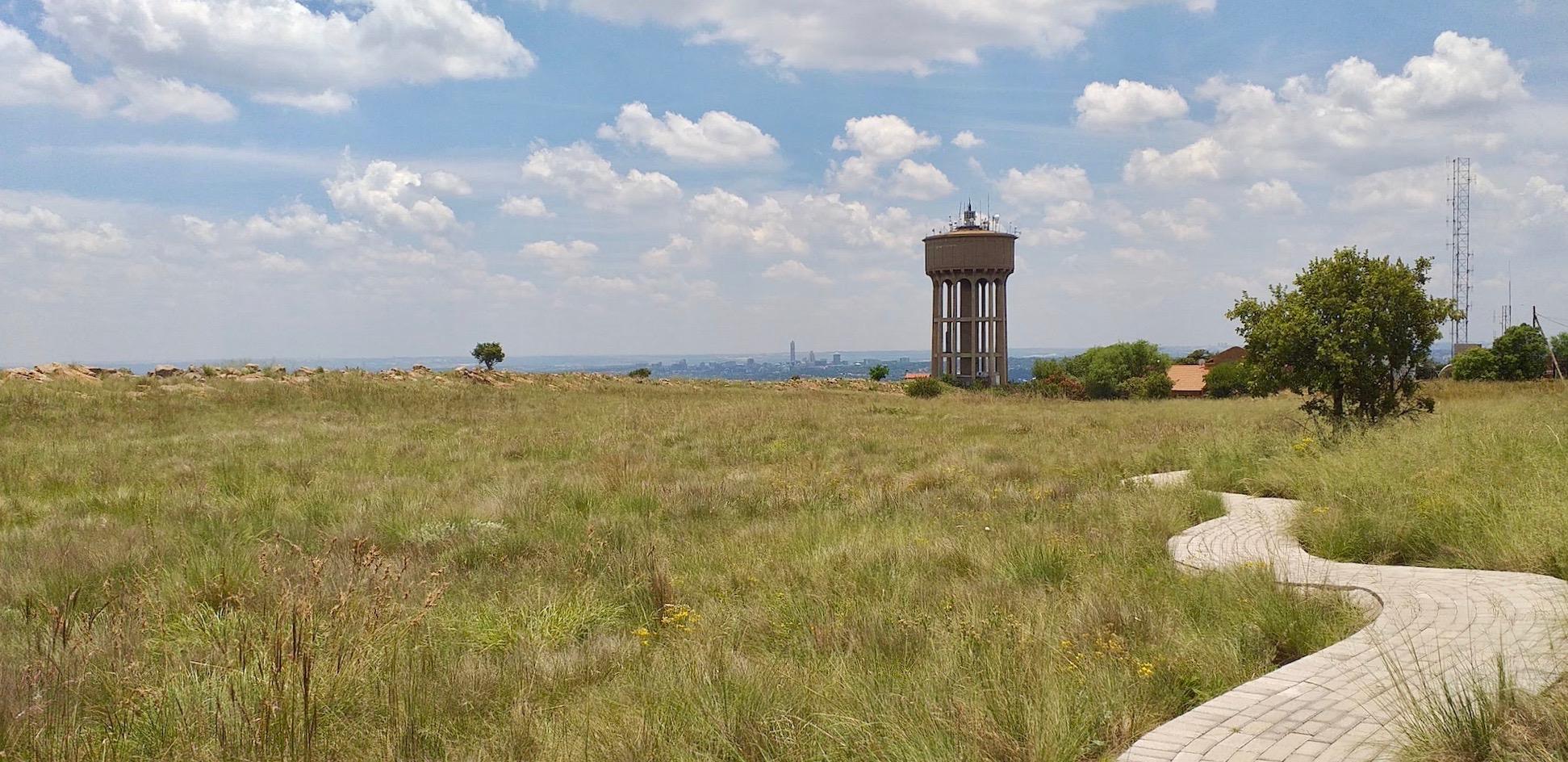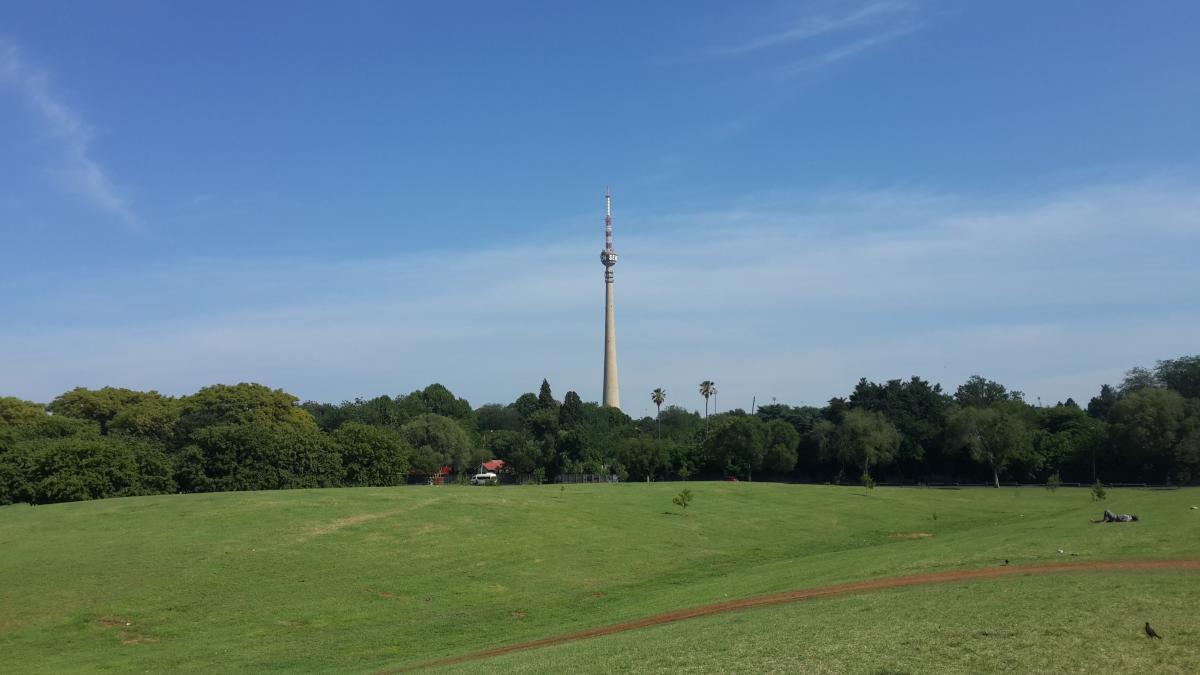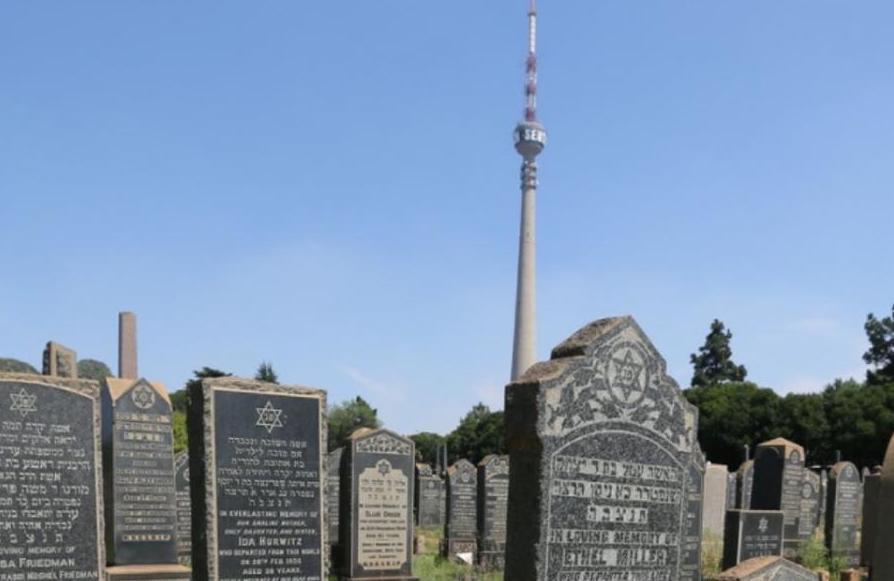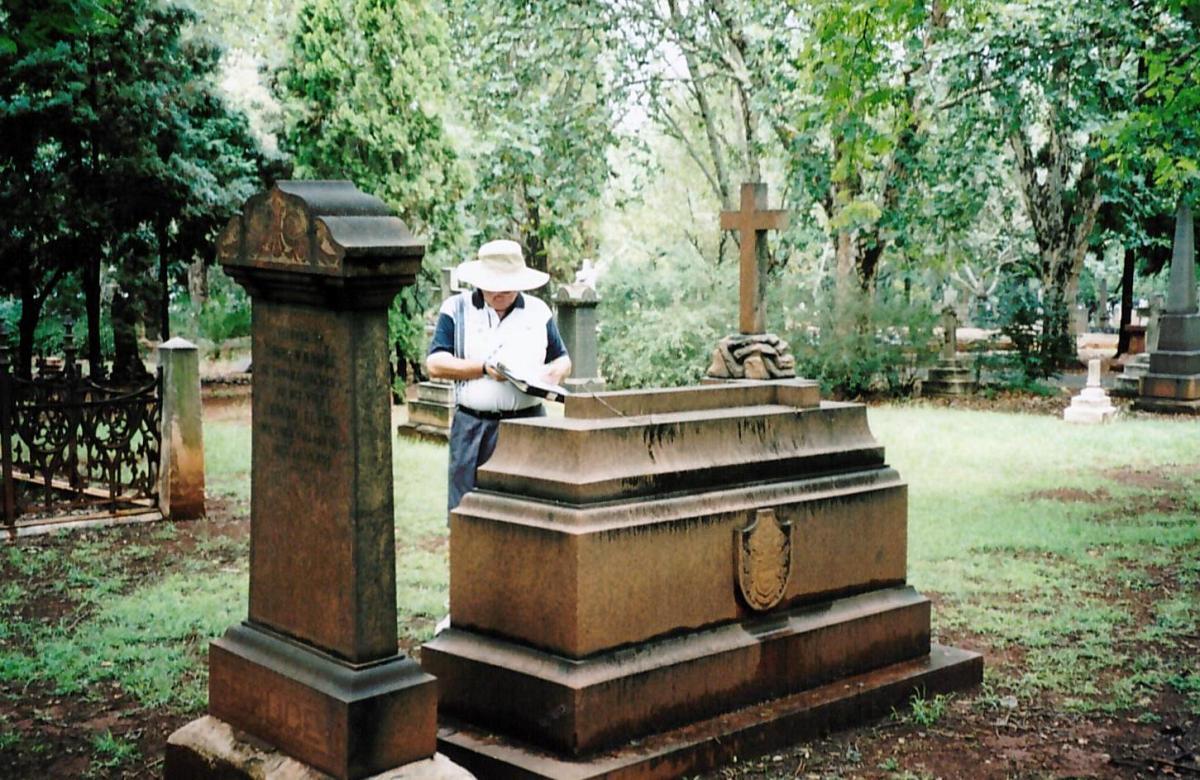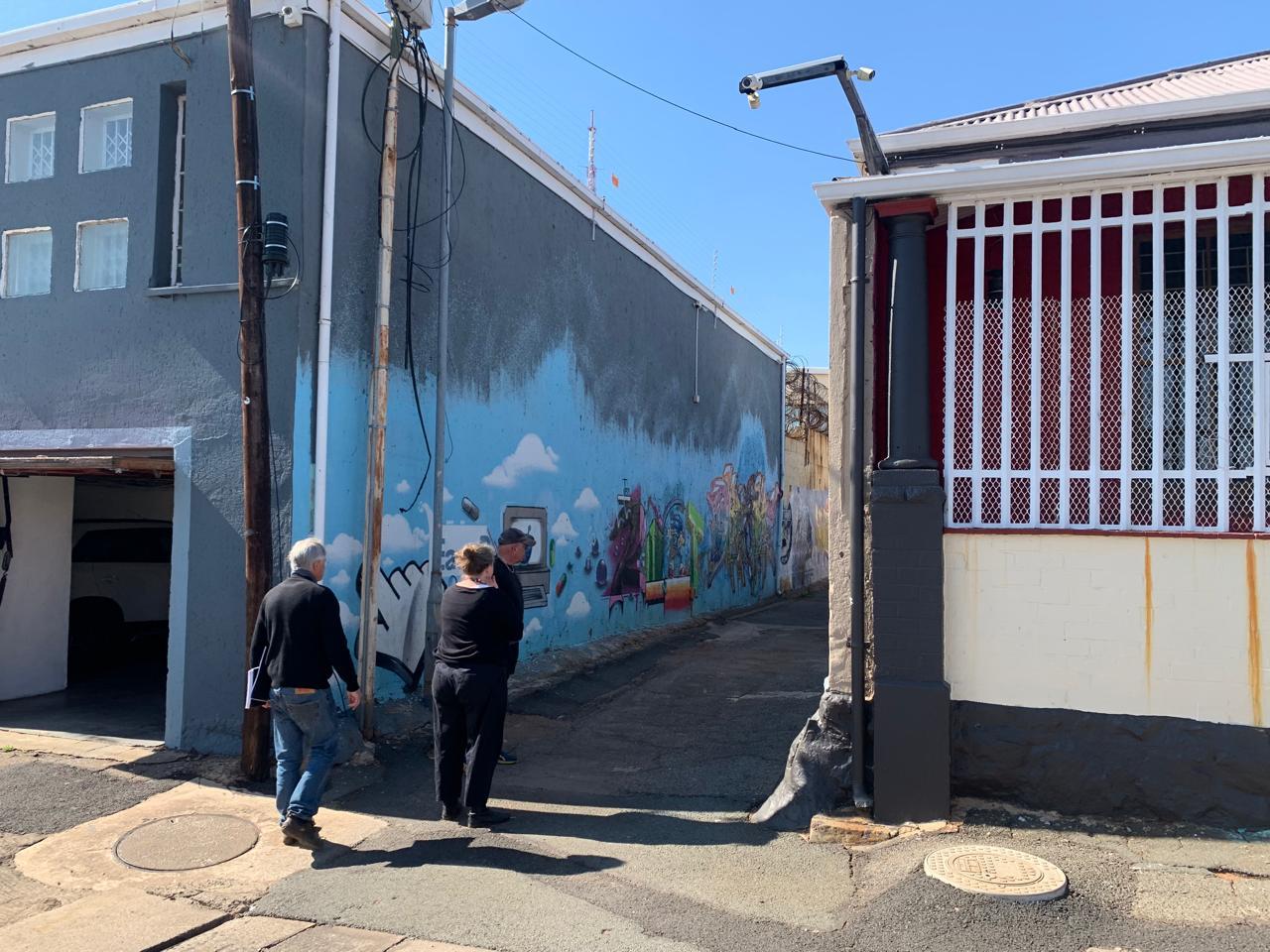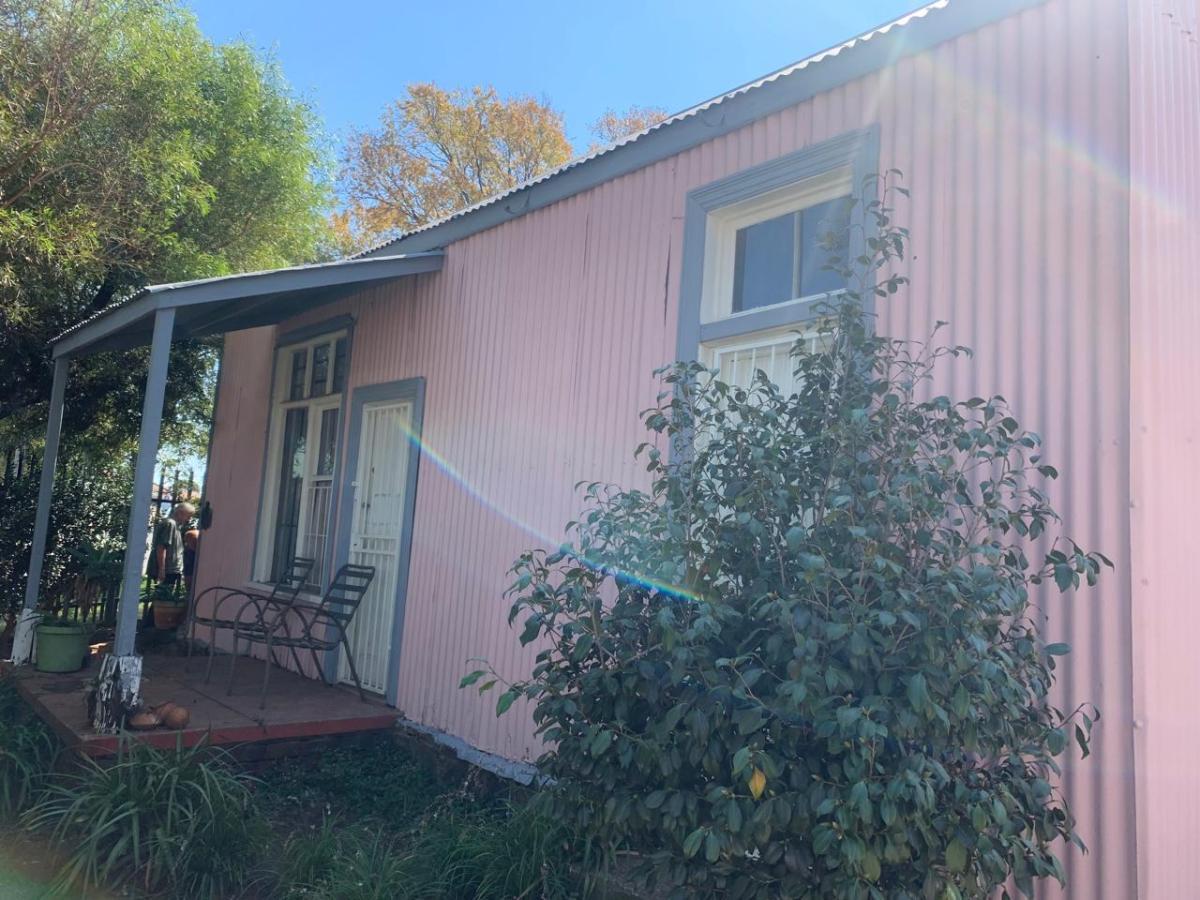
Disclaimer: Any views expressed by individuals and organisations are their own and do not in any way represent the views of The Heritage Portal. If you find any mistakes or historical inaccuracies, please contact the editor.
The City of Johannesburg and Johannesburg Heritage Foundation honoured Brixton with a blue plaque in April 2024 for one of the earliest wood and iron buildings. This is the first of a series of blue plaques for this popular community-minded suburb revealing a growing awareness that many sites and places are worthy of heritage recognition.
Blue plaque (Kathy Munro)
Remarkably this shop-cum dwelling had already been declared a National Monument in 1983, by the old National Monuments Council. After 1994, the Council was dissolved in favour of a new provincial system but the old NMC badge has been preserved.
Old National Monument plaque (Kathy Munro)
The objective of a Johannesburg blue plaque is to encourage an appreciation of local heritage properties. A blue plaque is a symbol of civil society recognition.
Brixton was surveyed in 1902 for the Auckland Park Real Estate Company on land that had been part of the Braamfontein farm. It was named for its counterpart, the suburb of Brixton in London. Using street names such as Fulham, The Serpentine, Whitehall, Chiswick, Isleworth, Surbiton, Kew, Uxbridge, Threadneedle, Putney and Hampton was a marketing ploy by the property company to make the new suburb attractive to English immigrants. The London names offered a familiar echo of possible past lives. Here was a small slice of the heart of Empire set down in a colonial mining town, caught up in speculative fever. The Transvaal was now a British colony and the “uitlanders” were in command. This suburb aimed to a attract a solid artisan class aspiring to home ownership.
The suburb was named Brixton by Horatio Collins (and there is also a Collins Street) who was the secretary of the property company. 500 stands went on sale in 1903, each one 50 x 100 feet, and sold on auction on liberal terms on a 99-year lease basis. Loans were available for those wanting to build their own homes, cottages, villas, or other residences, at 7 per cent per annum interest and covering 50% of the cost of building. But the suburb would not have been built over in the first round of the sale of stands; houses were erected through the later decades of settlement and construction.
The suburb of Brixton is situated on one of the ridges of the Witwatersrand and Brixton residents are proud of the fact that they live on the continental divide. It is a convenient suburb located close to the city centre and bounded by Rossmore, Auckland Park and Cottesloe to the North, Hurst Hill to the West, Vrededorp to the East and Mayfair to the South. It extends over 56 hectares, but this does not include the Brixton cemetery which lies to the east of the suburb of Brixton.
The original modest houses on the small stands were typical of the early decades of the 20th century, clustered together with street views from stoeps, hip roofs, square shape, using local building material. The selling point for Brixton was that 'building operations should be comparatively cheap and easy’, because the Johannesburg brick factories were nearby in Brickfields; with sand and stone being obtained from the real estate company.
This early wood and iron structure on the corner of Wimbledon and Fulham roads is a remnant of this period. It was built in 1904 and combined the function of a home and a corner shop, hence is one of the earliest shops in Brixton. A shop of this type would have served passing customers with perhaps, breads, eggs, milk, a quarter pound of cheese or a block of margarine or butter. The hours of opening would have been irregular and long, early morning and late evenings. It reminds people what Brixton was like when it was first settled by a white artisan class. It is one of the few remaining examples of wood and iron construction that belongs to the first decades of the dusty young mining town. That type of partially prefabricated house was common in the downtown streets clustering around the old Market Square. As the town expanded, such structures were also erected in nearby emerging suburbs. The corrugated iron was imported and was transported form the ports by rail or ox wagon.
It was built in Victorian style, with a hip roof and sash windows. Interior ceilings would have been prefabricated as pressed steel panels. A notable feature is the front door entrance, set at an angle facing the street corner. It was meant to invite and attract the passing traffic approaching from both streets. In the early days, corner stands commanded a premium price because it was an obvious location for a local business.
Sketch of the wood and iron shop-cum dwelling (Eric Brindeau)
Eric Brindeau’s 1991 study 'An Architectural Guide to Brixton through the Ages' (University of Port Elizabeth) discussed the hierarchy of space in the interior arrangement of this building. The shop and its storeroom constituted the front rooms and were larger than the back bedroom, dining room and kitchen. There was no interior Water Closet (toilet) or bathroom. Ablution facilities would have been outside the house. The floors were layered with timber decking (often Oregon pine) and the ceilings fashioned from prefabricated pressed steel. The outside walls may have been painted white and the roof a dark red. Alternative colours would have depended on what was cheaper or readily available at the time.
Today the yard has been fenced off and the main access is through a side gate on Fulham Road. There is a stoep with a bench placed against the front window and the yard has become a parking spot for a car. Nevertheless, it is a good spot for a sundowner, watching the passing pedestrians on the street. The community has supplied a cheerful pink paint, albeit out of context as it was not an option in 1904.
The stoep (Kathy Munro)
Social and business practice and the role for the shop on the corner has come full circle. Today many of Johannesburg’s poorer suburbs also have informal shops – pass through Yeoville and explore Mayfair and you will spot the spaza shops, open at late hours for the purchase of beers, cigarettes, washing powder or bread. All those forgotten simple household necessities. Structurally such little shops could be an add on or a converted garage or back room. It seems that Johannesburgers old or new, have always used the urban space imaginatively!
The High Street of Brixton was planned along British town planning concepts of the time. It is still is the main business street of the suburb. The name signals a high street in a London village or English town, but here it is more of a motley street of small businesses, shops and houses. There are used car lots, hardware shops, furniture stores, supermarkets, grocery stores, and corner cafes. There is also a municipal swimming pool.
One shop not on the High Street but with an important history to tell was the Chinese shop, at the corner of Caroline and Chiswick. It closed in 2018 and for a while was an art gallery but has fallen into disrepair. A 2018 exhibition celebrated the Chinese family, the Hongs, and their culture. They ran the shop for over half a century. It was a cross between a convenience store and a general dealer. Times have changed and the shop awaits a new opportunity.
In the early years, the most popular sites were the “charming view sites” and even today, as mentioned, Brixton people take pride in their suburb being on the continental divide. The sense of community cohered around shops, churches, schools and two parks, the principal one being the Kingston Frost Park.
Kingston Frost Park, war memorial to the fore, tennis club behind and the Brixton Water Tower in the distance. (Kathy Munro)
Kingston Frost Park is the principal public park for Brixton. It’s a park for chilling and watching the sun go down. It offers a fine view towards Northcliff. Anna Smith records that the South African Townships Mining and Finance Corporation donated eight stands in Brixton for a public park as recorded in the City Council Minutes in 1925. Originally the Park was known as the Brixton Park. However, in 1939 the City Council honoured Councillors by renaming parks across the city. Hence this park was renamed for AC Kingston Frost, a former long serving city councillor. There is also a small memorial on the rocks to the local men who lost their lives in the First World War fighting for the British Empire and King George. The names are inscribed on a sombre granite obelisk sitting on a base of ancient koppie rocks anchored forever on the ridge. The two panels of names are the records of the men and their families who lived in Brixton – Borrowman, Cage, Cross, Duffield, Mack, Maynes, Nelson, Paskin, Robertson, Tredoux, Van Blerk and Webb. These were twelve men who served in various regiments and units with their rank preceding their names and their regiment following.
Further along Fulham Road, a block away from the wood and iron house, is the Brixton Water Tower and Reservoir. It is an imposing structure, erected in the 1930s. The availability of a water supply on the western boundary of the suburb, provided by “the Water Company” was an original selling point for the first purchasers of stands. The water tower is now nearly a century old and almost a piece of industrial archaeology.
Brixton Water Tower (Kathy Munro)
The cylindrical shape, concrete construction, open arches, and a reservoir above it was the work of the City Engineers Department. They constructed several similar water towers using this specific design between the wars (e.g. Yeoville and Northcliff). I am passionate about the evolving design of Johannesburg water towers in the 20th century as in a town where a plentiful water supply for a growing city is challenge, the water tower and the principle of pressure to deliver water is critical. It is certainly worth marking water history on this ridge with a blue plaque.
Northcliff Water Tower (The Heritage Portal)
The sixties made Brixton the focal point of the possibilities and promise of television with the erection in 1961-2 of a broadcasting tower at the apex of the Brixton ridge. It is a cantilevered, shafted, tapering tower and has a high-speed lift and a restaurant at the very top. It is a product of its time, when the state managed and delivered on some grandiose projects. It was erected by the engineering firm Ove Arup. In its day it was the tallest structure in Africa and viewed as an architectural marvel. Originally named after the Minister of Posts and Telegraphs, Albert Hertzog, the tower has been renamed the Sentech Tower. It quickly became an iconic site in Johannesburg – a great viewpoint to show off our city to the South and East. After sixty years it too deserves a heritage marker.
Sentech Tower (The Heritage Portal)
Alongside the Sentech Tower, at more earthy rooted ground level, was an even stranger Brixton oddity – the Irish Volunteer Monument. It was a memorial to the Irish volunteers, men who fought on the side of the Boer forces in the Anglo Boer War (the now named South African War of 1899 – 1902). It was erected in 1975 and the the architect was Jan Van Wyk (who also designed the Paarl Taal Monument). It comprised a group of four truncated sturdy concrete cylinders of differing heights. Strangely, the memorial was stolen in the dead of night in 2002 by a group of ardent Afrikaners and taken to the distant all white Afrikaner town of Oranje where Verwoerd and his ideals still imbue values. It’s an echo of the past in more senses than one. It could be an archaeological ruin as all that remains is flattened grass and a sunken circle. The story of the memorial is contentious and raises debate about whose heritage, why heritage and what is significant heritage to a specific community who live in a suburb.
A new addition to the Brixton scene is Bridge Books at the Breeze Block Café, opened in February 2024 by the entrepreneurial book dealer, Griffen Shea. It is a combination of bookshelves, coffee and lunch and is open six days a week (Tuesday to Sunday). The focus is on African and Johannesburg interest books. “It’s a cool space” adds Griffen. The Goethe institute has a library in the upstairs section and, at the Lapa, artists are offered a three-to-six-month residency and exhibition opportunity.
Brixton as a place became familiar to old Johannesburg citizens because of the Brixton Cemetery. It was Johannesburg’s second cemetery developed from 1908, and was the successor to the Braamfontein cemetery. It was the cemetery for Johannesburg’s citizens until it ran out of space and was succeeded by West Park Cemetery in 1942. As the city grew, it needed a sizeable burial ground. Brixton Cemetery is located approximately one kilometre west of the older Braamfontein Cemetery. The first burial in the new cemetery at Brixton was in 1910. It extends over 84 acres (35 hectares). Brixton comprises many family plots, hence people continued to be buried here even after West Park had been opened.
Brixton Cemetery
Tracking early maps of Johannesburg shows that Brixton cemetery appears as a green patch alongside the suburb of Brixton, bounded by Caroline Street, Bartlett Street and Krause Street Vrededorp, with the entrance in Krause. A 1910 municipal map of the city shows Brixton Cemetery labelled as the New Cemetery with the suburb of Brixton as a near neighbour. A 1936 Johannesburg tourist map shows the cemetery as Brixton Cemetery. I find myself puzzling as to whether the Brixton community feels an ownership of the cemetery, and that the cemetery is part of the suburb. I am assured by my colleague Prof Paul Kotze that indeed Brixton does. There is an opportunity for more Brixton community involvement in the Friends of the Cemeteries who have worked on Brixton Cemetery graves and are planning more tombstone restoration days.
A volunteer inspecting a grave at Brixton Cemetery (Friends of the Cemeteries)
As journalist and Heritage Portal contributor, Lucille Davie explains it is the final resting place of many men and women who made Johannesburg – mining magnates, trade unionists, strike leaders of the 1922 strike, engineers, newspaper editors, the victims of Daisy de Melker’s poisonous rampage, soldiers of the First and Second World War, geologists, architects, prospectors, and miners were all buried here a century ago. The beloved deceased were separated in death by church affiliations and race. Here you will find the graves for the Church of England, Dutch Reformed, Roman Catholic, Non-conformist churches and Presbyterian members. There are separate sections for Chinese, Indian and African graves. For me a cemetery is always a lesson in history as one reads inscriptions on tombstones for clues about lives and beliefs about the hereafter, dates of long and short lives and records of the careers of men and women of the city. I have written about the Brixton Cemetery in another Heritage Portal article (click here to read). There is also a Jewish section to the cemetery, though that area is kept under firm lock and key.
As one of Johannesburg’s oldest suburbs, Brixton embodies a sense of history and pride. Its residents give it a new social identity as home to artists, architects, and academics. Here people walk the streets, pause and chat; they collect litter and plant pavement gardens. Originally fences and walls were low or non-existent but today walls are higher, traditional verandas are protected by palisade barriers and street views are cut off. Houses are often modernized, extended, and gentrified. The corrugated iron roofs have often been replaced by modern looking tiles – ceramic or slate. Those who believe in the character bestowed by original stoeps, street frontages and cottage designs are saddened by the changes that seem relentless. Some of the local sanitary lanes have become public pathways and cheerful back boundary walls display graffiti art and express happy or darker moods – all the colours of the rainbow and it is the community that has provided the paint.
Graffiti in Brixton (Kathy Munro)
Brixton has championed its suburb with a spectacular annual festival of lights. They celebrate their community and its location. They proudly shout out that they live on the African continental divide. The light festival now attracts thousands of Johannesburg people.
We congratulate Brixton on its first blue plaque and anticipate more to come.
Thanks to Lucille Davie, Marc Latilla and Sarah Welham for conversations about the Brixton cemetery and its naming. Grateful thanks for the critical reading of earlier drafts of this article by Louis Grundlingh, Paulo Da Silva and Paul Kotze.
Kathy Munro is an Honorary Associate Professor in the School of Architecture and Planning at the University of the Witwatersrand. She enjoyed a long career as an academic and in management at Wits University. She trained as an economic historian. She is an enthusiastic book person and has built her own somewhat eclectic book collection over 40 years. Her interests cover Africana, Johannesburg history, history, art history, travel, business and banking histories. She researches and writes on historical architecture and heritage matters. She is a member of the Board of the Johannesburg Heritage Foundation and is a docent at the Wits Arts Museum. She is currently working on a couple of projects on Johannesburg architects and is researching South African architects, war cemeteries and memorials. Kathy is a member of the online book community the Library thing and recommends this cataloging website and worldwide network as a book lover's haven. She is also the Chairperson of HASA.
References
- Anna H Smith: Johannesburg Street Names. A Dictionary of Street, Suburb and Other Place Names, Compiled to the end of 1968. ( Juta, 1971)
- Eric Brindeau: An Architectural Guide to Brixton through the Ages. Department of Architecture, University of Port Elizabeth (unpublished, 1991 )
- Geographic Street Atlas of Greater Gauteng, 6th Edition. No date
- Lucille Davie. A Journey through Johannesburg’s Parks, Cemeteries and Zoo. (Johannesburg City Parks, 2014)
Comments will load below. If for any reason none appear click here for some troubleshooting tips. If you would like to post a comment and need instructions click here.

